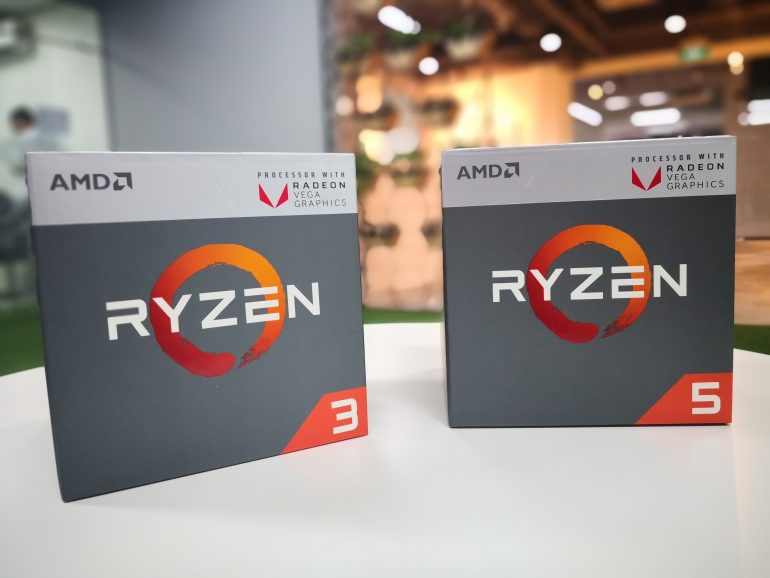Let’s start with a short history lesson on the AMD Accelerated Processing Units (APUs). When AMD first launched their APU based on the Llano architecture in 2011, they were ahead of their time. The vision of APUs were great – is it possible to integrate a GPU into the same CPU die so that users can enjoy the best of both worlds just on a single SoC? AMD saw the potential of GPU computing and the decreasing significance of CPUs as their performance saturates.
Their foresight is coming true today. Intel is slowing down their research and development in new CPU architectures, which has been shown in the disruption in their “Tick-Tock” cycle. There just isn’t much of a need for us to create even faster compute processors for the mainstream market!
On the other hand, GPU computing requirements are at an all-time high, as research and development saw the advantage in parallel computing. In fact, they are everywhere today:
- A.I. and Machine Learning solutions makes use of GPU for computation due to their efficient parallel nature
- Gamers who seeks higher resolutions and higher frame rates still have yet to find the perfect product to feed their need
- Cryptographic algorithms in popular blockchain algorithms are accelerated by GPUs
It is obvious that the future lies in GPUs and parallel programming. Even Intel knows about it, and that is why, they are said to be developing their own GPU as well! Currently, they can only adopt solutions from AMD to include as discrete graphics solutions on their chip.
Good thing that AMD was early in the race with their concept of APUs, allowing them to learn from their previous products and come out with iterative improvements to them. It’s not easy to be working on both CPU and GPU technologies at the same time, while ensuring that both technologies will just magically work together. There needs to be synergies and innovation at all levels across the company and even between research and development departments. Their early products laid the foundation of what the AMD Ryzen APUs are today.
With improved architecture and process technology, AMD was able to bring a whole new level of performance to their new current line-up of APUs. In the past, APUs were known to be slow in terms of both CPU and GPU performance. Let’s see how far ahead AMD has gone with their new Ryzen APUs!
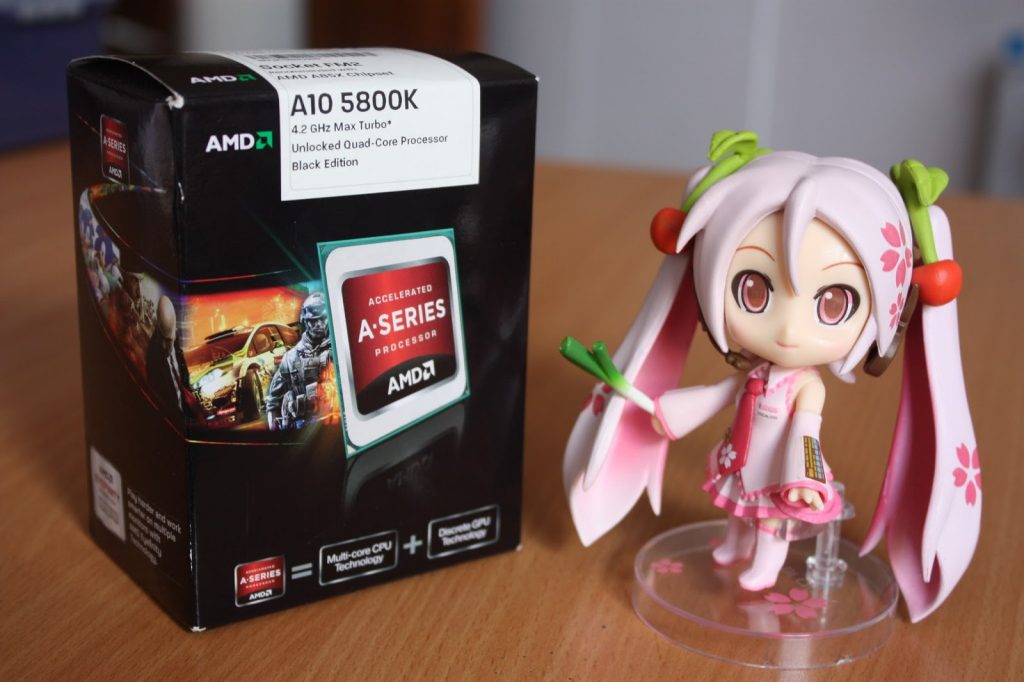
Well… we can’t believe that it has been 5 years since our last APU review! That article should be a good comparison to show much the APU technology (and us) has grown over the years!
The Ryzen APU “Raven Ridge” microarchitecture
With the new “Zen” architecture which took 4 years to develop, AMD was able to put themselves back into the competition with Intel’s latest offerings. Their new processors were able to give consumers to bang for the buck, and were so popular that Chief Executive Lisa Su even claims that the Ryzen desktop processors took up 40 to 50% of sales at some online retail stores. There is no doubt that the Ryzen CPUs are one of the best performing desktop processors out in the market today.
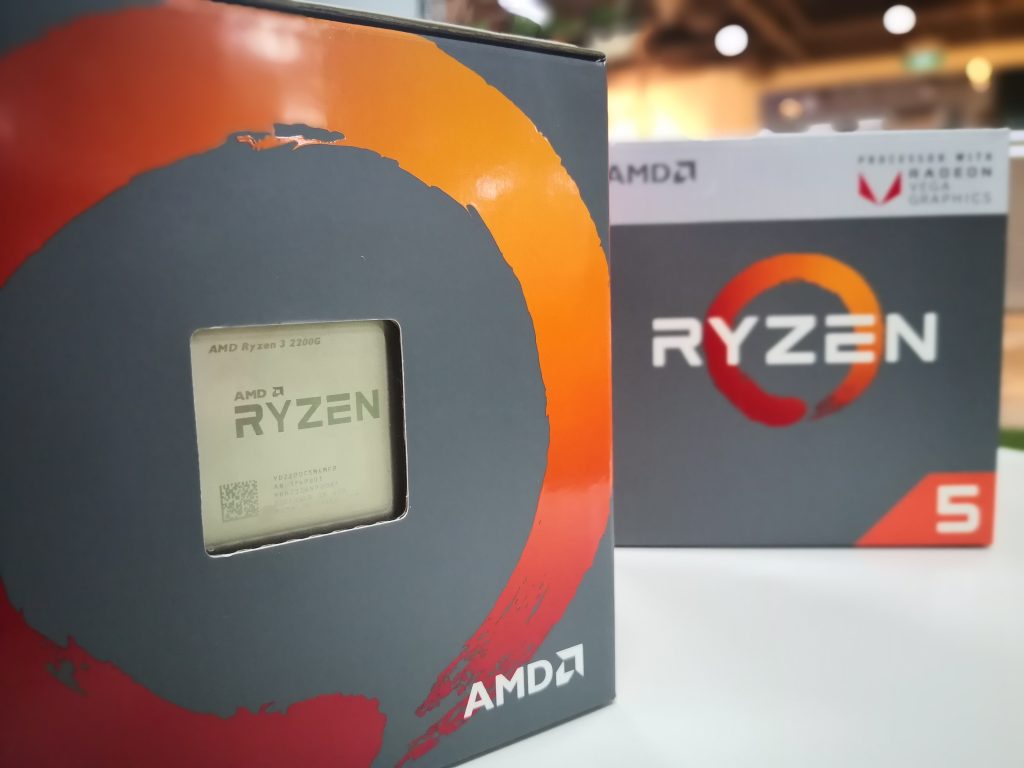
How about their innovation in the APU space? As mentioned, it just isn’t that straightforward to use black duct tape to stick the CPU and GPU together and call it a new APU. There is a need for proper design and integration before a usable product can be introduced to the market… and AMD had it all thought out with their new Infinity Fabric interconnect technology. This gave birth to the “Raven Ridge” CPU microarchitecture.
If you remember the HyperTransport technology that is used as an interconnect between the different components on the SoC, you will definitely understand the purpose of the Infinity Fabric. In fact, the Infinity Fabric is a superset of the HyperTransport technology. With Infinity Fabric, each component will have the bandwith of 30GBytes/s to 512GBytes/s. Technically, this bandwidth will allow different kinds of connections that requires extremely high bandwidth, and will allow AMD to scale easily with multiple core.
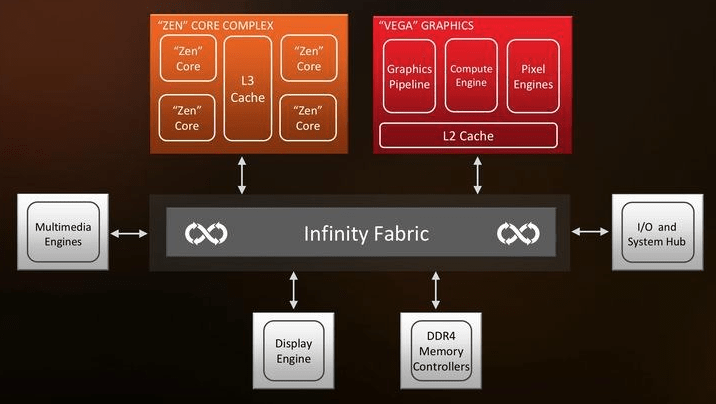
The Vega graphics that is found on the new Ryzen APUs also use this new interconnect technology to provide graphics processing capabilities to consumers on a chip.
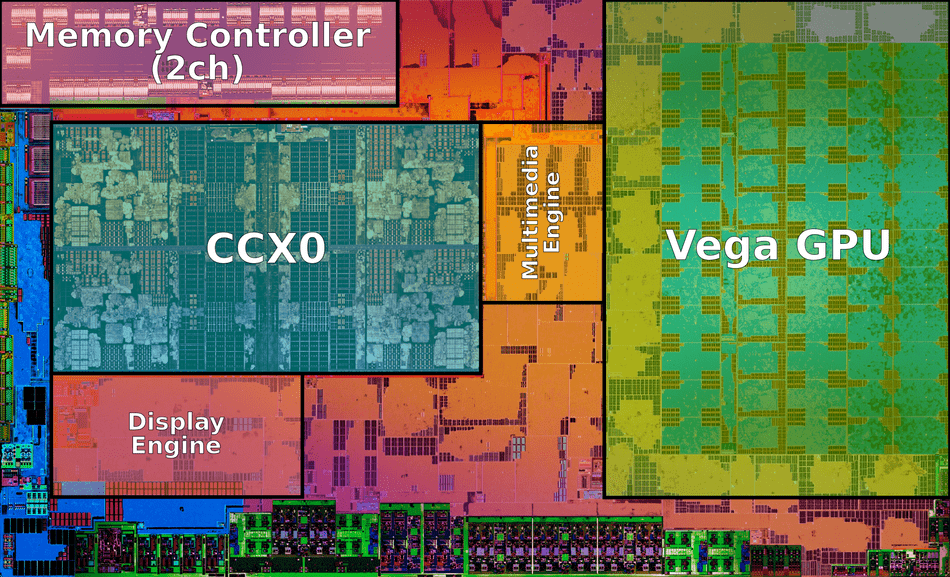
Each Core Complex (CCX) provides 4 compute cores to the CPU. The new AMD Ryzen APUs will have a single CCX, making it a quad-core processor that is paired with a discrete GPU unit based on AMD’s latest Vega GPU architecture. The rest of the components on the SoC are largely similar to those on an actual Ryzen CPU.
Ryzen APUs realised in 2 forms – Ryzen 5 2400G and Ryzen 3 2200G
| Core/ Threads |
Base/ Boost |
Graphics Model | Graphics Core Count | Max. GPU Clock | L2/L3 cache | TDP | Price
(S$) |
|
| Ryzen 5 2400G | 4/8 | 3.6GHz/ 3.9GHz |
Radeon Vega 11 | 11 (704 Stream Processors) | 1,250MHz | 6MB | 65W | $234 |
| Ryzen 3 2200G | 4/4 | 3.5GHz/ 3.7GHz |
Radeon Vega 8 | 8 (512 Stream Processors) | 1,110MHz | 6MB | 65W | $144 |
AMD aims to have their latest “Raven Ridge” APUs to be a single solution that can handle 1080p gaming. First and foremost, the gaming performance will be directly related to the capabilities of the graphics processing unit. Both Ryzen 5 2400G and Ryzen 3 2200G are equipped with the same GPU that are based on the latest “Vega” architecture. This is AMD Radeon’s latest offering for the GPU side of the house. Secondly, CPU frequency also matters, as it could bottleneck the GPU from reaching its full potential. Therefore, both the new Ryzen chips have their frequencies set in excess of 3GHz to ensure that no bottlenecks happen.
Both the Ryzen 5 2400G and Ryzen 3 2200G will be totally replacing the Ryzen 5 1500 and Ryzen 3 1200 models. Do take note that the new APUs are still based on the initial “Zen” architecture, but not the refreshed “Zen+” architecture. There are some differences that comes with the new Ryzen APUs. The new APUs currently only has a single four-core CCX (Core Complex), rather than having dual four-core CCX. This also results in a smaller amount of L3 cache that is dedicated, as each CCX only has 4MB. However, this should not affect performance at all due to the nature of the design of these chips.
Testing Objectives
Of course, we will be curious on the performance difference technologies that are 5 years apart. We will first compare the new Ryzen 5 2400G and Ryzen 3 2200G with the A10 5800K. We will also find out if the new Ryzen APUs will actually perform well with games at 1080p settings, while comparing it with the AMD Radeon RX550.
The AMD Radeon RX550 is currently the cheapest graphics card that you can purchase from the market today. It is still based on the previous generation Polaris architecture, instead of the Vega architecture. From this comparison, we can also determine if there is an actual need to still invest in a discrete graphics card for gaming, with the availability of the new APUs.
Test Setup
| Specifications | Hardware |
| CPU | Ryzen 5 2400G, Ryzen 3 2200G |
| RAM | G.Skill Sniper X DDR4 3400 CL16-16-16-36 2 x 8GB DDR4 Kit |
| Storage | Samsung 850 Evo M.2 SATA 250GB SSD |
| GPU | Vega 11, Vega 8, Sapphire Pulse RX550 2GB |
| Motherboard | MSI B350I PRO AC |
| CPU Cooler | AMD Wraith Stealth Cooler (Stock) |
| OS | Windows 10 Pro 64 bit |
| Drivers | Radeon Software Adrenaline Edition 18.5.1 |
The new AMD Ryzen APUs should also make it even easier for gaming on a Mini-ITX system. Even though the Mini-ITX platform is meant to create a new slew of powerful small form factor PCs, they are largely limited by the graphics performance due to the lack of space for heat dissipation. The new Ryzen APUs should change the situation, as the system will be slightly less complex without the need for a dedicated graphics card attached. Moreover, the APU should also operate at a lower temperature as compared to its predecessors due to the smaller 14nm process technology that it is on.
Test Results
Results Disclaimer – Benchmarks taken that are compared with the A10 5800K are to be taken with a pinch of salt. Both systems fundamentally are running on different platforms, operating systems, hardware and drivers, which could contribute the disparity in results. Also, do take note that the game benchmarks were running in 1280 x 720 resolution, with the same settings as the A10 5800K review.







We can really see the huge performance difference between technologies that are five years apart, and we must really commend AMD on their efforts placed on the new Ryzen processors with Vega graphics.
Do you still need a dedicated graphics card?
Benchmarks were running on 1080p resolution, on their default settings.



Interestingly, we can say that the Vega 8 and Vega 11 graphics performed well for simple games that did not require a large amount of video memory, such as Dota 2. We explained more about this problem in our review of the Radeon RX550, when compared to the Vega GPU found on the Ryzen APUs.
However, when it comes to the newer titles, it barely reaches 30FPS and more settings has to be lowered to reach this minimum threshold of playability. Nonetheless, it’s the fastest ever APU/iGPU we’ve ever seen before.
Final Thoughts and Conclusion
The AMD Ryzen APU with Radeon RX Vega Graphics poses a great deal of value for consumers who are looking to build a new computer system. We have seen how much AMD has grown by learning from their past mistakes. We were glad that their efforts have paid off, as the AMD Ryzen APU with Radeon RX Vega Graphics is a huge step forward for APU products, bringing adequate performance on both CPU and GPU ends to a single APU chip.
If you are on a budget and seeks to build a new computer system that is able to handle simple games in 1080p resolution, there’s no other products in the market that comes near to the AMD Ryzen APU with Radeon RX Vega Graphics in terms of value. Regardless, both Ryzen 3 2200G and Ryzen 5 2400G will give you the performance required, but if budget allows, do consider the Ryzen 5 2400G, as it has a better GPU, and will perform better with games.


